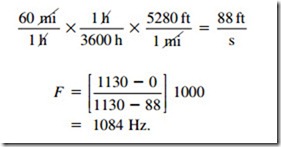Doppler Effect
We have all experienced the Doppler effect—hearing the pitch change from a higher frequency to a lower frequency as a train whistle or a car horn comes toward a stationary listener and then recedes into the distance. The frequency heard by the listener due to the velocity of the source, the listener, or some combination of both is found by
where FL is the frequency heard by the listener (observer in Hz), FS is the frequency of the sound source in Hz, c is the velocity of sound in ft/s, VL is the velocity of the listener in ft/s, and VS is the velocity of the sound source in ft/s.
Use minus (–) if VS in the denominator is coming toward the listener. If the listener, VL, in the numerator is moving away from the source, use minus (–), and for the listener moving toward the source, use plus (+).
Example
Assume c = 1130 ft/s, VL = 0, VS = 60 mi/h (approaching listener), and FS = 1000 Hz
This rapid sweep of 156 Hz is called the Doppler effect. A very large excursion low-frequency driver can exhibit Doppler distortion of its signal. Moving vanes in reverberation chambers can produce Doppler effects in the reflected signals that can cause unexpected difficulties in modern spectrum analyzers.



